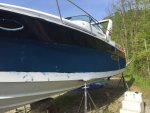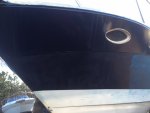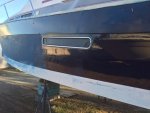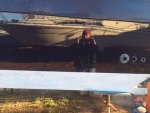Hello - I purchased a '89 Fourwinns 315 vista that I planned to paint and modernize the look of the boat by painting the hull a dark blue. After failing to find someone to paint the boat at a budget that I could afford, I decided to undertake this project alone. I have gotten myself in a pickle many times along the way but have learned immensely. I now need some guidance on how to get some deep scratches out of the paint that I inflicted while sanding. Here are the notables: I used Epihanes monourethane paint. Primed it using their primer, than rolled and tipped 3 coats of the finish, sanding in between but not liking the finished look. Re-sanded the boat and elected to learn how to spay the boat, spraying 3 coats of the finish. This paint is a very "sensitive" paint to any moisture in the air or drop in temperature, and takes a long time to cure. What I was left with was some nicely painted areas and some that resulted in a lot of "orange peel." I've wet sanded the finished coat using a DA sander and a lot of 1000 and 1500 grit paper and then used the 3M method of buffing the finish to a mirror like surface. Pictures forthcoming.
Here is my dilemma, I lost my patience on some heavy orange peel areas using a lot of 1000/1500 g paper that I decided to try wet sanding it using 800g. The 800g did flatten out the orange peel but left some deep scratch marks that using 1000/1500g will not take out. Should I continue trying to get them out with the 1000/1500g paper or do I need to re-sand this area with the 800g to get it consistent and then re-sand with the 1000/1500g? I don't want to create more problems than I already have...thanks for your help. Frank
Here is my dilemma, I lost my patience on some heavy orange peel areas using a lot of 1000/1500 g paper that I decided to try wet sanding it using 800g. The 800g did flatten out the orange peel but left some deep scratch marks that using 1000/1500g will not take out. Should I continue trying to get them out with the 1000/1500g paper or do I need to re-sand this area with the 800g to get it consistent and then re-sand with the 1000/1500g? I don't want to create more problems than I already have...thanks for your help. Frank
























